This is a page within the www.staffshomeguard.co.uk website. To see full contents, go to SITE MAP.
HOME GUARD MEMORIES AND INFORMATION - WARWICKSHIRE,
BIRMINGHAM
Cpl. ERIC HOLBECHE
of
the
STONEHOUSE
ANTI-AIRCRAFT BATTERY, HARBORNE
|
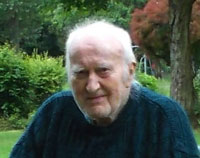 Corporal
Eric Holbeche
(1921-2018)
was a
member of the
Stonehouse Platoon
of the
Harborne Home Guard unit
whose duty was to help man the
nearby Royal Artillery
Z-battery, a defensive
installation equipped with
anti-aircraft rockets, rather
than conventional guns. This was
located close to the Stonehouse
pub. It was the
101
Warwickshire Home Guard AA Rocket Battery
commanded, appropriately, by a
Major D.L. Gunn. Corporal
Eric Holbeche
(1921-2018)
was a
member of the
Stonehouse Platoon
of the
Harborne Home Guard unit
whose duty was to help man the
nearby Royal Artillery
Z-battery, a defensive
installation equipped with
anti-aircraft rockets, rather
than conventional guns. This was
located close to the Stonehouse
pub. It was the
101
Warwickshire Home Guard AA Rocket Battery
commanded, appropriately, by a
Major D.L. Gunn.
(Detailed
information about the operation
of this type of weaponry can be
seen
here).
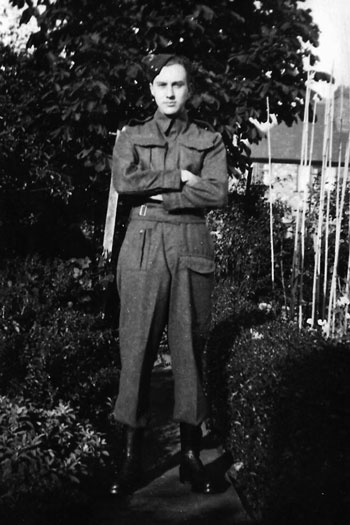 Eric
Holbeche was an Austin Apprentice at
Longbridge
from 1937
to 1942. He was then employed as a
Planning engineer in Jig & Tool
Design. The clouds of war were already
looming at an early stage of his
apprenticeship: a very early job was
to help with the preparation of
measures to camouflage the Works. He
recalls painting factory roofs to look
like rows of houses.
Contemporary descriptions of these
arrangements confirm its effectiveness
with the factory effectively blending
into the landscape; and, with one
tragic exception, they seem to have
helped protect the area from any major
aerial attack. Eric
Holbeche was an Austin Apprentice at
Longbridge
from 1937
to 1942. He was then employed as a
Planning engineer in Jig & Tool
Design. The clouds of war were already
looming at an early stage of his
apprenticeship: a very early job was
to help with the preparation of
measures to camouflage the Works. He
recalls painting factory roofs to look
like rows of houses.
Contemporary descriptions of these
arrangements confirm its effectiveness
with the factory effectively blending
into the landscape; and, with one
tragic exception, they seem to have
helped protect the area from any major
aerial attack.
At some
stage he joined the Home Guard, not
the
Austin
factory unit
but the Stonehouse platoon and was
directed to anti-aircraft duties. This
is a picture (left) of him taken in
the garden of his home in
Gristhorpe
Road, Stirchley
in 1942, resplendent in smart uniform
and impressively polished boots and
gaiters.
The
duties were arduous. He did one
night in eight from 6pm to 6am
and also went for training
sessions each Sunday.
He
found it exhausting when he did
overnight duty, often after a
full day's work, and then at the
end of the Home Guard shift
having to go on to Longbridge to
do the following day's work.
He became an
instructor himself and trained
new members when they joined.
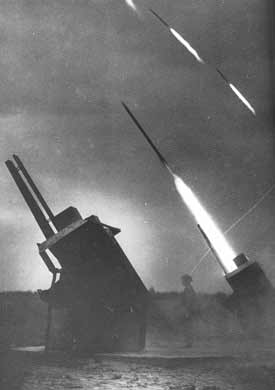 His unit
was in charge of four batteries of
sixteen anti-aircraft rockets, and
they fired two salvos at once.
The rocket launchers were made
of flimsy material which
reminded Eric of milk crates and
which, he felt, could easily be
knocked up in a garage. His unit
was in charge of four batteries of
sixteen anti-aircraft rockets, and
they fired two salvos at once.
The rocket launchers were made
of flimsy material which
reminded Eric of milk crates and
which, he felt, could easily be
knocked up in a garage.
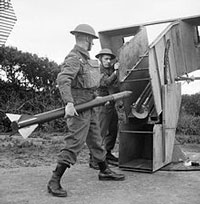 The
rockets themselves were
fired using power from a car
battery. By the time he joined
the unit the worst of the
air-raids was over and he never
fired in anger since there was
no attack whenever he was on duty;
rockets were however fired on
occasions when he wasn't there
himself. But he did go to
New
Brighton on a couple of
occasions for training when they
fired the missiles over the
promenade. The
rockets themselves were
fired using power from a car
battery. By the time he joined
the unit the worst of the
air-raids was over and he never
fired in anger since there was
no attack whenever he was on duty;
rockets were however fired on
occasions when he wasn't there
himself. But he did go to
New
Brighton on a couple of
occasions for training when they
fired the missiles over the
promenade.
He
recalls marching through
Weoley
Castle on one occasion with the
U.S. Army, although he cannot
recall what the parade was for.
He also says that they were
allowed the facilities of the
Royal Artillery NAAFI, although
they were prevented from buying
razor blades eventually, as the
regulars were going short.
Luckily they were still allowed
to buy the
beer!
In addition to his Home Guard duties
he also did fire-watching duty
with the Fire Service, along with
his elder brother and one of his
sisters.
Within Eric's papers there
survives a wonderful group image
showing members of the local
Battery. Another member of the
Stonehouse Ack-Ack Gang whose
reminiscence is shown below,
recalled that the unit, the
101
Warwickshire Home Guard,
comprised 8 groups of about 140
men, on duty one night in eight;
and the following image is of the
group of which Eric was a member.
It is undated but was almost
certainly taken in 1943 or 1944.
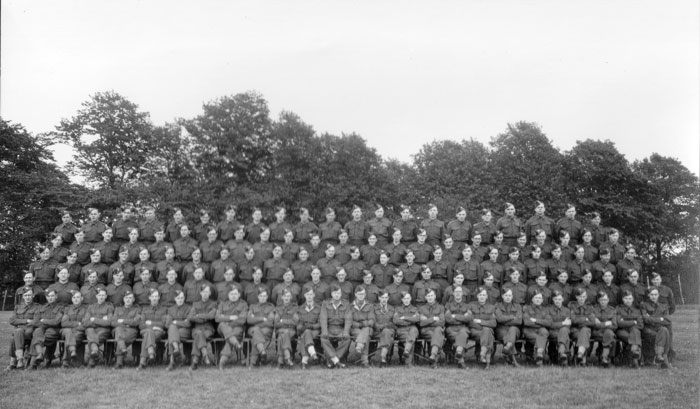
Eric Holbeche is seated extreme
right, front row.
Click
image to view magnified version
Acknowledgements
Grateful acknowledgement is made to Susan Holbeche
for the information about her father and
for her permission to publish it in this website; and to Matt Felkin
and his "Wartime
Birmingham and the Blitz" Facebook page.
Images of Eric Holbeche ©
Susan Holbeche
2016
In memory of
Eric Holbeche
and all his comrades
in
The Stonehouse Gang
Home Guard
|
***************
ANOTHER MEMORY OF THE
STONEHOUSE UNIT
Gunner
Dennis Nash
recorded his memories in 2003 in the
BBC People's War website.
In 1940, after I turned 17, I was
conscripted into the Home Guard. Ours was
an ACK-ACK (anti-aircraft) Unit and I
belonged to the Stonehouse Gang at
Harborne in Birmingham. There were another
5 or 6 such units located around the city.
We were issued with a combat uniform
and helmet and also a greatcoat. This had
a red band on the arm with ACK-ACK on it
and a picture of an anti-aircraft gun. On
the shoulder flash were the words 'Home
Guard'. Other members of the gang were
either aged 45+ and too old for the
regular army, or like me they were in a
reserved occupation.
The Stonehouse
Gang was made up of 8 groups of up to 140
men. We were on duty for one night in
every eight. We had to report for duty by
7pm, or ealier if possible, and our shift
finished at 7am. We slept in Nissen Huts,
about 28 - 30 men per hut. We had a bunk
with 2 blankets on. We were given supper
at 9pm and breakfast in the morning before
leaving for work. These meals were in
addition to our normal rations. If the
alarm went off in the night and we were
out for more than 45 minutes we were given
cocoa too!
Like most people at
that time I cycled everywhere: 4 or 5
miles from Quinton to Oldbury, back home
for tea, then another 4 miles to Harborne
for Home Guard duty. Then after my night
shift I would cycle to Oldbury to do my
'day job'.
We did our training on
Sunday mornings. This mainly consisted of
'Rocket Drill': collecting ammunition,
altering the angle of projection and the
bearing of the rockets and firing. We were
using high precision guns and shells. We
had 64 rocket projectors, each of which
fired two rockets simultaneously, and thus
had to be operated by two men. The rockets
were about 5 feet long and exploded on
altitude. When there was an air raid they
were all fired together, the barrage of
explosions causing the maximum damage to
enemy aircraft. The amazing thing about
the projectors was that they were only
powered by a 4.5 volt torch battery!
Twice during the war I had to go on
firing courses, once to Liverpool and also
to Swansea. It was at The Mumbles that I
remember quite a frightening experience.
After firing one of our anti-aircraft
rockets a flagstone was uprooted and this
made me realise what power these rockets
had.
©
Dennis Nash 2003
To
read the rest of this article
please click here. (You will leave this site. WW2 People's War is an online archive of wartime memories contributed by members of the public and gathered by the BBC. The complete archive can be found at
www.bbc.co.uk/history/ww2peopleswar.)
|
Detailed Information
is contained
on a
page in this website
about the operation of Z-Batteries.
(And for
further pages on this subject, please use the
Search
function).
Other Memories and Information
about the Warwickshire Home Guard
can be found by
clicking the
MEMS -
WARKS link below.
Contribution of
Information
And if you can
contribute in any way to our knowledge of the Home
Guard in Warwickshire and adjoining counties, please do so via the
Feedback link.
x129 - February 2016,
updated August 2019
|
|
|